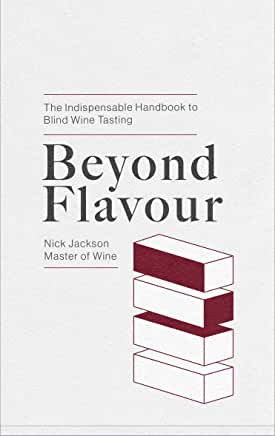
How to Taste Wine
How many times have you read an article in your favorite magazine and wondered how the author found so many flavors in a wine?
And where did those wine descriptions come from? Descriptions like velvet, tannin, and suede?
Or maybe you’re out for drinks, and that know-it-all friend of yours dominates the conversation with his discussion about the wine.
In the book Beyond Flavour, Nicholas Jackson, a Master of Wine, helps normal people learn to taste the many flavors and aromas in a wine in an easy-to-understand fashion.
He helps people understand the structural components of a wine.
**Click Here for Wine Resources**
How to Taste Wine : Understanding Structure
In the Master of Wine educational program – and also the Court of Master Sommeliers – students are taught how to taste wine by breaking down the components of a wine without knowing its variety or origin.
Having passed the challenging examination, Master of Wine Jackson shows average people how they can achieve wine mastery with these simple techniques.
**Click Here to Read the Original Article Via Forbes.com with More Tips and Techniques**
It’s important to know that this book includes proven material, based on the many years he spent mentoring students in the Masters of Wine education program.
For casual wine lovers, the lessons you will learn in Beyond Flavour will help you raise your level of understanding and enjoying wine.
Curious why experts used texture like velvet, suede, and satin to describe wine?How to Taste Wine : What is Structure in a Wine
The word “structure” refers to the different elements professional wine tasters use when analyzing wine.
Let’s look at a key structural element called tannins. Tannins can be found in virtually all red wines.
Think of the astringent taste and sensation of black tea. Feel it (real or imaginary) as it fills your mouth and goes down your throat. This is how you can recognize tannins.
In red wine, tannins come from the grape itself. Tannins can also result from oak maturation. They are usually described in terms of texture, like you might feel in a piece of cloth.
Why Tannins Matter
In a wine like Rioja from Spain, tannins are a huge clue to its identity. That’s because long aging is a signature of Rioja wine. It used to be that the wine was aged only in American oak, yet the new trend is for French oak that gives it a different flavor profile.
In this book, you will learn how to distinguish the type of oak, and the length of maturation.
The definition of the term “acidity” in wine is relatively easy to guess. Acidity refers to a tart sensation you feel, almost like a squirt of lemon as you sip the wine. It is often found in wines made from a high-acid grape like Sauvignon Blanc or Pinot Grigio.
How to Taste Wine : Key Elements of This book
Nick Jackson may have received a degree from the UK’s University of Cambridge. Yet he writes in a clear, easy to understand manner with his to-the-point sentence structure.
This is a streamlined look at the science of wine tasting filled with practical wine tasting exercises. In some ways it is almost like a “cliff note” shortcut to the elements of blind tasting.
What I liked best about the book is that it reflects Mr. Jackson’s original approach to teaching others about wine In one class, Mr. Jackson poured out five high-acid wines (among a Sauvignon Blanc and a Riesling) and asked the participants to “feel” the “shape of the vibrations.
”How to Taste Wine : Personal Markers
Every taster – including myself – develops their own personal clues and references to help them identify wine blind. I often (correctly) deduce the identity of a wine by what is known as a “personal marker.”
People instinctively have (or soon develop) a personal marker for certain wines. But there are two problems with personal markers.
The first is that a personal marker can lead you astray. This can happen if you jump to conclusions without taking the time to analyze the structure. Once you have analyzed the structure, you must check again to see if the wine fits the profile of its true variety and origin.
Even if so, the taster must try to figure out what else the wine can be.
Personal Wine Markers : Are They Valid?
The second problem is that while a personal marker can “quicken” the time it may take you to figure out a wine’s identity, you will never be able to write the marker down on the answer sheet and get “credit” for it. Personal markers, as the name implies, are best off kept inside one’s own head.
As an example, many people have a personal marker for the wine Gewurztraminer. As the wine typically has a sweet floral aroma, a common personal marker is “my aunt’s floral hand lotion.” As described above, it can take you to the category of wines with sweet floral aromatics, but that is where the use of the marker will end.
You will have to use the specific analytic terms to decide if what you think is Gewurztraminer may really be Muscat or Torrontés.
Final Thoughts
This is a great book for everyone who is curious how to deduce a wine’s identity when tasting it blind.
Do you want to see this original book review, published in Forbes.com?
Like this article? Chcck out these excellent wine book reviews here.
Please SHARE this article visit the social media links and subscribe to my newsletter here
If you like this article you will like:
— Dominus Estate
— Chappellet Family Winery
— Hess Collection
— Frog’s Leap
Curious to Learn More About Wine? Start Here
Want to Grab Quick Wine Resources?
About Author Marisa D’Vari
D’Vari contributes to Forbes.com, Financial Times, World of Fine Wine, Quarterly Review of Wine, Decanter Robb Report, San Francisco Chronicle, South China Morning Post, and more.
She holds the (WSET) diploma, Certified Sommelier through the Court of Master Sommeliers, a Certified Wine Educator through the Society of Wine Educators … to see it all, please click on bio
Here is a great video on how to taste wine

